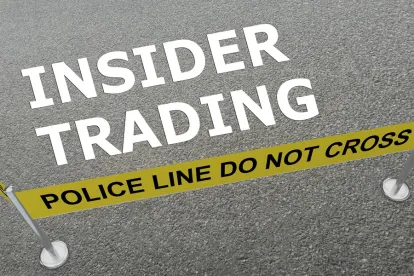Co-coaching your daughters’ basketball team with your brother-in-law and later profiting from buying stock in your brother-in-law’s company is not, in and of itself, insider trading. This seems fairly obvious. On Monday, December 13, 2021, U.S. District Judge Claude Hilton in northern Virginia agreed when – during trial – he found that the Securities and Exchange Commission (the “SEC”) did not present sufficient evidence that Christopher J. Clark’s trading activities related to his co-coach/brother-in-law’s company constituted illegal insider trading.1
Clark’s trading was flagged as suspicious because, as the SEC argued, his trades had “an improbable success rate.” The SEC took the position that Clark’s too-good-to-be-true trades, combined with the fact that Clark spent ample time with his brother-in-law and borrowed money to make the trades at issue, clearly pointed to insider trading. Instead of presenting testimony or other direct evidence, the SEC’s case largely hinged on its statistical surveillance tools’ identification of the trades as “highly suspicious.”
A corporate insider that provides material, non-public information to a family member or friend who then trades on the basis of that information commits insider trading in violation of Section 10(b) of the Securities and Exchange Act and SEC’s Rule 10b-5.2 A “tippee” like Clark can also be held liable for trading on material, non-public information if they knew, or should have known, that the information was given to them in breach of a fiduciary duty.3
The purported “insider” in Clark’s case was his brother-in-law, the corporate controller for CEB Inc., a company that provided business support services to executives. The government alleged that Clark’s brother-in-law provided Clark with material, nonpublic information about CEB’s forthcoming $2.6 billion merger with Gartner, an S&P 500 company engaged in technology research and consulting. The brother-in-law was sued in the same complaint as Clark in December 2020, but instead of taking his case to trial, he settled with the SEC for $240,000 without admitting or denying his guilt.
Not all information shared by a corporate insider to friends and family constitutes “material, nonpublic information,” however. Suppose, for example, that Clark noticed his brother-in-law was showing up to basketball practice more tired and stressed than usual, or that while apologizing to his family for needing to step away from a holiday dinner, the brother-in-law said something like “work has been crazy lately.” In this hypothetical, Clark’s observations of his brother-in-law’s stress or knowledge that things had been “crazy” at work could lead to the inference that CBE was going to merge with a larger company. But it could also lead to the inference that CBE was in financial trouble, or that Clark’s individual job could be in trouble.
Further, Clark’s interpretation of his brother-in-law’s behavior does not fit neatly into the mosaic theory4 of insider trading. For the trading to have fit into the mosaic theory, the brother-in-law would have had to provide small pieces of non-public information which, when combined with other facts known by Clark, could in total be considered material non-public information (and form the basis for improper trades). Clark’s behavior interpretation certainly does not fit into the traditional tiper/tippee theory, which would’ve required the brother-in-law to have deliberately or recklessly provided Clark with information he knew to be material and non-public, either.
If, however, the SEC had produced evidence that Clark had actually received material, non-public information from his brother-in-law, Clark’s case might have ended differently. The SEC recently charged three individuals in a similar set of circumstances in which, allegedly, Florida businessman David Schottenstein and his accomplices traded on material, non-public information given to Schottenstein by his cousin and uncle, both of whom sat on the board of several publically traded companies. The SEC still has to prove its case against Schottenstein, but, unlike in Clark’s case, this complaint alleges that the SEC has actual evidence that the cousin and uncle were the source of Schottenstein’s information.
Clark’s case underscores that insider trading charges should not hinge solely on inferences. Judge Hilton saw no testimony, texts, emails, or other direct, or even circumstantial, evidence demonstrating that Clark’s brother-in-law relayed material, non-public information to Clark – instead the Judge referred only to the SEC’s “talk about highly suspicious trading.” Judge Hilton added, in this case, “[t]here’s just simply no circumstantial evidence here that gives rise to an inference that he received the insider information.” The ruling is still appealable, but Clark’s case demonstrates that the SEC’s statistical evidence is not the end-all-be-all – where unsupported by direct evidence, SEC statistical evidence is challengeable.
The case also re-enforces the value of insider trading compliance policies, procedures, and training for company personnel, so companies and their employees can demonstrate that they understand their duties to protect confidential information. Policies and procedures may have increased importance in the near future, as newly proposed amendments to SEC rules include requirements that companies annually disclose their insider trading policies and procedures. Clark may have avoided liability in this instance, but the line between “insider trading” and “knowing an insider and trading” remains thin, and personnel should be well-trained to avoid disclosing non-public information.
1. The trades at issue were Clark (and his son’s) purchase of out-of-the-money call options on CEB stock. The SEC’s complaint details Clark’s trading activity as follows:
"In 15 transactions between December 9, 2016 and January 3, 2017, Clark purchased 377 out-of-the-money, short-term CEB call options for a combined $33,050. Clark also directed his son to purchase similar options. On all but five occasions, Clark’s purchases represented 100% of the option series volume for that day. On four of the five remaining occasions, the only other purchaser of those call options was Clark’s son."
2. Salman v. U.S., 137 S. Ct. 420, 427 (2016).
3. Dirks v. S.E.C., 463 U.S. 646, 660 (1983).
4. The mosaic theory involves collecting public, non-public, and non-material information about a company and by combining it, turning that information into material non-public information about the company.




 />i
/>i

